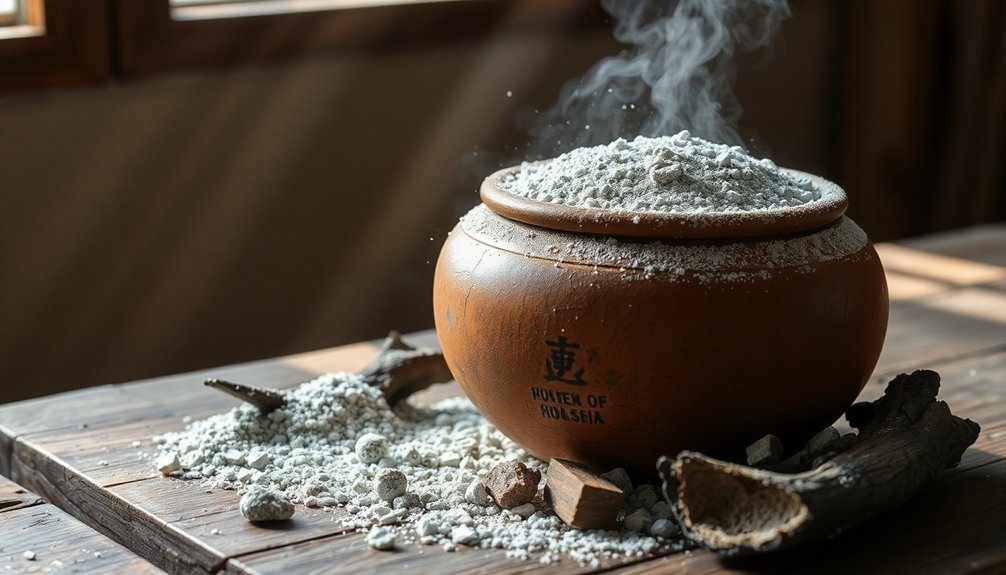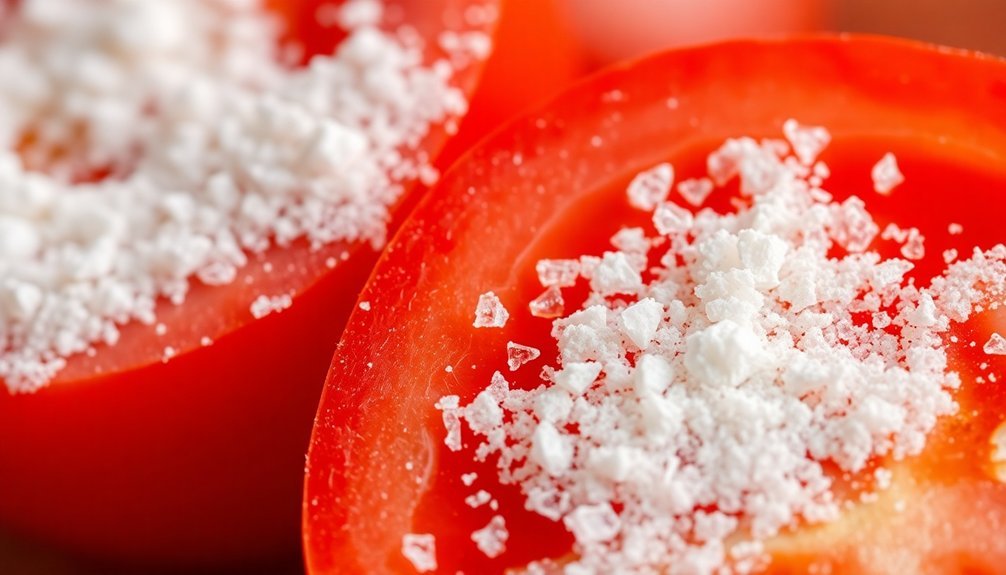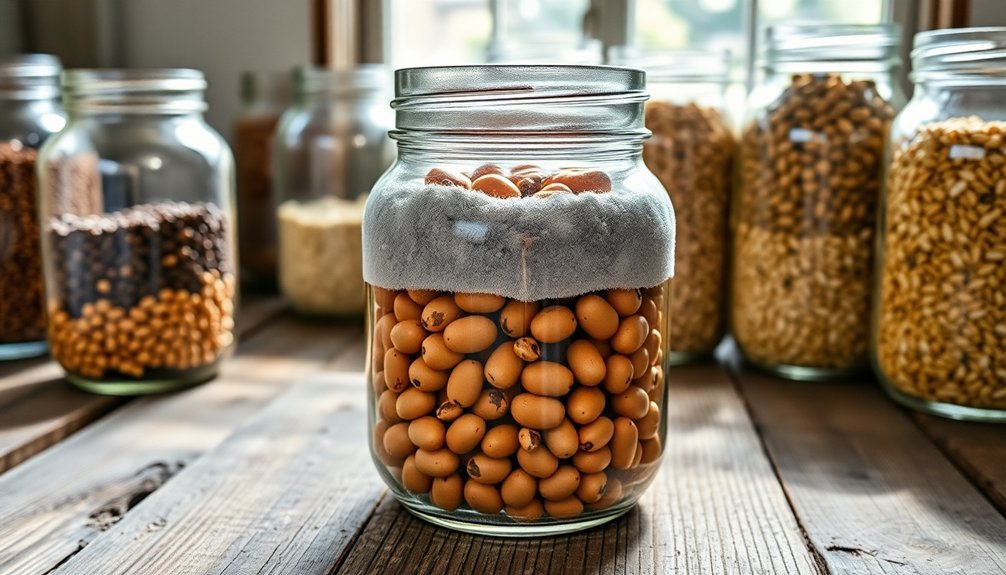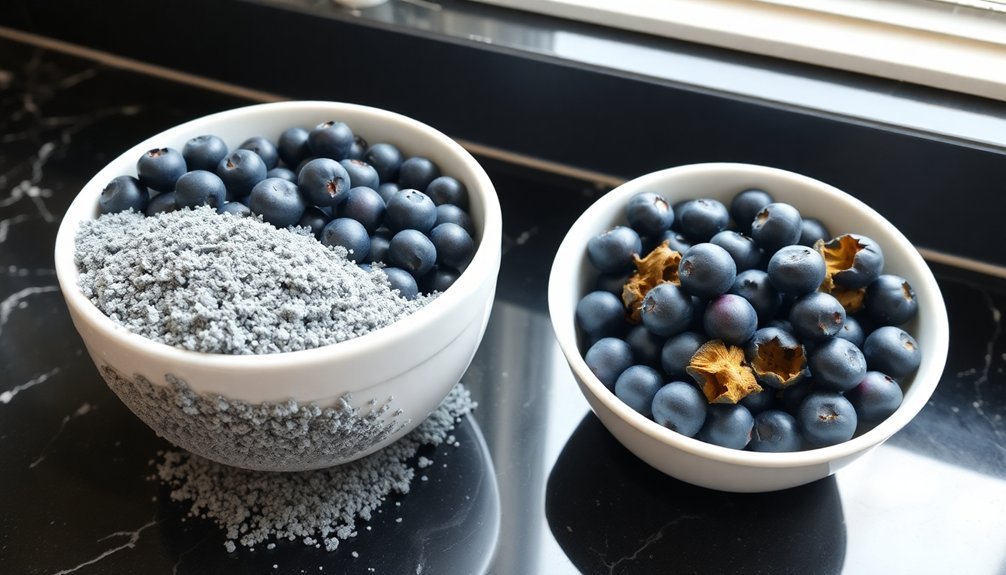Ash preserves your food through multiple natural mechanisms that have been trusted for thousands of years. It creates a powerful alkaline barrier with a pH of 9-13 that actively repels harmful bacteria while its moisture-wicking properties pull excess water away from food. The minerals in ash, including calcium carbonate (25-45%) and potassium (10%), work together to disrupt bacterial cell membranes and prevent spoilage. You'll find this preservation method especially effective for eggs, hard cheeses, meats, and even ripe tomatoes – extending their freshness from months to nearly a year. Ancient civilizations clearly understood something we're just beginning to rediscover.
Ancient Science Behind Ash Preservation

Stretching back through millennia, the practice of using ash to preserve food reveals humanity's early mastery of chemical preservation. What you might find fascinating is that ancient civilizations across multiple continents discovered ash's remarkable preservative properties independently of one another. From the Mesoamerican nixtamalization process to Roman wine clarification, they'd figured out ash's potential long before modern chemistry could explain why it worked.
You'll find the science behind this preservation method is surprisingly sophisticated. When you use ash to preserve food, you're actually employing its natural alkaline properties to create an environment where harmful bacteria and fungi can't thrive. The ash's ability to absorb moisture also plays a significant role – it keeps your food dry, which further prevents spoilage.
What's particularly clever about this ancient method is how versatile it proved to be. You could preserve everything from eggs and tomatoes to cheese and meat using different ash application techniques. Modern research has shown that ash-preserved foods maintain enhanced nutritional profiles.
The Cherokee people, for instance, mastered the use of hickory ash for meat preservation, while African farmers developed specific ratios of ash to protect their produce. Each culture adapted the method to their specific needs and available resources.
How Ash Fights Food Spoilage
When you use ash to preserve food, you're employing a powerful alkaline barrier that naturally repels harmful bacteria and prevents their growth.
The ash's high pH creates an inhospitable environment where most microorganisms can't survive, while its remarkable moisture-wicking properties pull water away from food surfaces. Experiments show that ash's potassium content of 10% contributes significantly to its preservation capabilities.
These two mechanisms work together, as the ash's ability to control moisture strengthens its antimicrobial effects, creating a formidable defense against food spoilage.
Alkaline Defense Against Bacteria
Throughout the history of food preservation, ash has served as nature's alkaline defender against bacterial growth. When you apply ash to food, you're creating a powerful alkaline barrier that most bacteria simply can't survive in.
Wood ash, in particular, dramatically raises the pH levels of the surrounding environment, making it hostile for harmful microorganisms. The process can help prevent up to 25% of food losses that typically occur due to microbial spoilage.
You'll find that ash's alkaline properties work by disrupting bacterial cell membranes, effectively killing these unwanted organisms. The process relies on various alkaline salts found in ash, including sodium, potassium, and magnesium compounds.
These minerals don't just create an unfavorable environment – they actively interfere with bacterial metabolic processes.
When you're preserving food with ash, you're utilizing a sophisticated natural defense system. The high pH environment prevents the growth of aerobic mesophiles and other spoilage-causing microorganisms that would normally break down your food.
It's particularly effective because the alkaline conditions don't just slow bacterial growth – they create an environment where many harmful bacteria can't function at all.
This is why foods preserved in ash can maintain their freshness for extended periods, sometimes lasting months or even years.
Moisture Control Properties
Ash's moisture-fighting power stands as an essential defense against food spoilage. When you store food in ash, it actively absorbs excess moisture, creating an environment where harmful bacteria and fungi can't thrive. This moisture absorption directly impacts water activity levels, which is significant for preventing microbial growth and chemical reactions that lead to spoilage.
You'll find that ash preservation works exceptionally well for various food items, maintaining their freshness through effective humidity control. Here's how ash affects different storage aspects:
| Storage Factor | How Ash Helps |
|---|---|
| Moisture | Absorbs excess water from food |
| Humidity | Creates dry environment |
| Water Activity | Reduces free moisture availability |
| Shelf Life | Extends preservation time |
Wood Ash Chemical Properties

You'll find wood ash excels at preserving food due to its highly basic pH levels, which create an inhospitable environment for spoilage-causing microorganisms.
The ash's rich mineral content, including calcium oxide and potassium compounds, actively draws moisture away from food while depositing beneficial trace elements.
These moisture-absorption properties, combined with the ash's natural antimicrobial characteristics, make it particularly effective at extending food storage life.
Basic Ph Levels
With the potent alkaline properties of wood ash ranging from pH 9 to 13, you're fundamentally dealing with a powerful soil amendment that rivals agricultural lime.
When you apply wood ash to food preservation, you'll find these high pH levels create an environment that's hostile to many microorganisms that cause food spoilage.
You'll need to understand that wood ash's alkalinity considerably affects the chemical balance of any substance it contacts. Just as it can raise soil pH above 7.0, it creates similar effects in food preservation scenarios.
When you're working with wood ash, you're utilizing its ability to shift pH levels quickly and considerably, which explains its effectiveness in preservation techniques.
You'll want to be cautious with application amounts, as the ash's strong alkaline properties can cause chemical changes that affect nutrient availability.
In food preservation, this same principle works to your advantage – the high pH creates conditions where harmful bacteria can't thrive.
The ash's rapid reaction with moisture and its ability to maintain elevated pH levels makes it particularly effective for long-term food storage, much like its lasting impact when used as a soil amendment.
Mineral Content Analysis
The diverse mineral composition in wood ash plays a significant role in food preservation. You'll find that calcium makes up the largest portion, with calcium carbonate comprising 25-45% of the total ash weight. This high calcium content creates an inhospitable environment for many food-spoiling microorganisms.
When you examine wood ash closely, you'll discover it contains substantial amounts of silicon dioxide (4-60%) and aluminum oxide (5-20%). These compounds work together to create a protective barrier around food.
The presence of potassium (0.4-14%) and sodium (0.2-0.5%) further enhances preservation by drawing moisture out of food, making it harder for bacteria to thrive.
You'll also find important trace minerals like iron, manganese, boron, copper, and zinc in wood ash. While these elements appear in smaller quantities, they contribute to the overall antimicrobial properties.
The ash's composition varies depending on the wood source and burning conditions, but it's the combination of these minerals that makes it an effective preservative. The presence of unburned carbon and high loss on ignition (up to 27%) can actually help absorb excess moisture, further aiding in food preservation.
Moisture Absorption Properties
Moisture absorption stands as one of wood ash's most valuable preservation properties. When you use wood ash for food preservation, you're utilizing its highly alkaline nature, which actively pulls moisture from the surrounding environment. The ash's chemical composition, particularly its calcium, magnesium, and potassium oxides, reacts with water to form hydroxides that enhance its desiccant capabilities.
| Property | Effect |
|---|---|
| Alkalinity | Draws moisture from food |
| Oxide Content | Forms moisture-absorbing hydroxides |
| Heat Release | Aids in desiccation process |
You'll find that hardwood ash, especially from oak and maple, works more effectively than softwood ash for preservation. When the ash's compounds interact with moisture, they create an environment that's inhospitable to bacteria and mold, which typically need water to thrive. The process isn't just about absorption – it's also about the chemical reactions that generate heat, further helping to dry out the food.
However, you'll need to be careful with the amount you use. Too much ash can alter the food's pH levels considerably, potentially affecting both taste and safety. The key is to apply just enough to create a protective, moisture-controlling barrier around your food items.
Foods Best Preserved With Ash
Throughout history, various foods have proven particularly well-suited for ash preservation, creating a reliable method for extending shelf life.
You'll find eggs can last nearly a year when stored in ash, which absorbs moisture and prevents bacterial growth. Just make certain they're crack-free and evenly coated.
Hard cheeses like Gruyere benefit from ash preservation too. You'll need to surround your cheese with 1 to 1.5 inches of sifted wood ash in a stoneware pot, where it'll form a protective rind. Remember to store it in a cool, dark place for best results.
For meat preservation, hickory ash has been particularly effective, as demonstrated by Cherokee traditions. You can preserve meat by storing it in ash layers, which both dehydrates the meat and prevents spoilage while adding flavor.
Even tomatoes can be preserved using this method. You'll want to choose ripe but firm tomatoes without blemishes, then layer them in ash without letting them touch each other. This technique can keep your tomatoes fresh for three to six months, as the ash absorbs excess moisture and prevents microbial growth.
Minerals That Matter

Inside every pinch of ash lies a powerful combination of essential minerals that make food preservation possible. These minerals work together to create an environment where food stays fresh for extended periods.
When you're using ash for preservation, you're actually harnessing the power of calcium, magnesium, potassium, and other crucial minerals that naturally combat food spoilage.
The most significant minerals you'll find in ash include:
- Calcium, which strengthens the preservation process by maintaining food structure
- Magnesium, which helps regulate moisture content and enzyme activity
- Potassium, which assists in maintaining proper mineral balance
- Manganese, which contributes to overall preservation stability
You'll find that these minerals don't just sit idly in your preserved foods. They're actively working to keep your food fresh by absorbing excess moisture and maintaining ideal pH levels.
While these minerals won't increase your food's nutritional value during preservation, they're necessary for creating an environment where bacteria and fungi can't thrive.
Understanding the mineral content of ash helps you appreciate why it's been such an effective preservation method throughout history, especially in cultures where modern preservation techniques weren't available.
Traditional Preservation Around The World
From ancient civilizations to modern societies, humans have developed ingenious methods to keep their food edible for longer periods. You'll find evidence of food preservation dating back to 12,000 B.C. in the Middle East, where people mastered drying techniques using sun and wind.
In the Inca Empire, you'd discover chuño, a freeze-dried potato that showcases their preservation prowess. Ancient Asian cultures pioneered pickling and fermentation, transforming ordinary foods into nutrient-rich staples.
In Nigeria, you'll encounter garri, a fermented cassava product that demonstrates how preservation can enhance both nutrition and flavor. Before modern refrigeration, people in cold climates preserved food by burying it in snow or storing it in icehouses.
You can trace curing and sugaring methods to the Greeks and Romans, who used salt and honey to prevent food spoilage. When the 1790s arrived, canning revolutionized preservation by creating sterile environments through heating and cooling.
These diverse methods share a common goal: reducing water content or creating inhospitable conditions for harmful microorganisms. Each technique reflects the ingenuity of different cultures in adapting to their environmental challenges.
From Farm To Storage

While ancient preservation methods laid the groundwork, successful food storage in ash begins long before the preservation process itself. You'll need to carefully select your food items, making sure they're in ideal condition for preservation. For tomatoes, choose ones that are ripe but firm, without any blemishes or soft spots. If you're preserving hard cheese, it should be thick enough to maintain its structure.
Before starting the preservation process, you'll need to prepare both your food and ash properly:
- Thoroughly clean and sort your food items to prevent contamination
- Sift the wood ash to remove any debris or large particles
- Arrange items like tomatoes upside down to prevent moisture buildup
- Prepare appropriate containers – wooden boxes, baskets, or stoneware pots work well
Once you've prepared everything, you'll layer your food items with the sifted ash in your chosen container. The ash acts as both a desiccant and natural pest deterrent, creating an environment that's inhospitable to spoilage.
Store your container in a cool, dark place, and make sure it's properly sealed to maintain the preservation environment. When done correctly, this method can keep food fresh for up to six months.
Modern Applications Of Ash
Modern applications of ash extend far beyond traditional food preservation methods. In today's food industry, you'll find ash content analysis playing an essential role in determining food quality, safety, and shelf life.
When manufacturers analyze ash content, they're actually measuring the mineral composition of your food, which directly impacts its texture, taste, and stability. You can see ash's importance in quality control processes, where it helps guarantee your food meets strict regulatory standards.
Higher ash content typically indicates more processing, while natural foods contain lower levels. When you're buying processed foods, manufacturers have carefully monitored ash levels to maintain consistent quality and comply with safety regulations.
In construction, you'll find ash being repurposed in fascinating ways. It's becoming a valuable component in road construction, where it can replace up to 50% of natural aggregates in base courses.
You might be driving on roads where municipal waste combustor ash serves as a granular base or fill material, particularly in Europe. This application not only provides a practical use for ash but also helps reduce the need for natural aggregates, making it an environmentally conscious choice.
Safe Usage And Best Practices

Successful food preservation with ash depends heavily on proper selection and preparation techniques. You'll need to start with ash from natural plant sources, carefully sifting it multiple times to remove any sharp particles or debris. Never use ash from materials that might contain harmful chemicals or toxins.
When you're ready to store your food, create a proper layering system in a suitable container like a wooden basket or stoneware pot. Start with a 1.5-inch ash base, then arrange your food items carefully. Each type of food requires specific handling:
- Store tomatoes stem-down in single layers, separating each layer with fresh ash
- Wrap cheese in cloth and surround it with 1-1.5 inches of sifted wood ash
- Place eggs in ash-filled containers for long-term storage
- Preserve meat using legume ash, ensuring complete coverage
Always choose fresh, unblemished produce for storage, and make sure your ash is completely cool before use.
The ash's basic properties and moisture-absorbing capabilities will naturally preserve your food by preventing bacterial and fungal growth. Keep your storage container in a cool, dry place, and you'll greatly extend your food's shelf life.
Frequently Asked Questions
Can Ash-Preserved Foods Be Safely Consumed During Pregnancy?
You shouldn't consume ash-preserved foods during pregnancy. They can harbor dangerous pathogens like Listeria, Salmonella, and E. coli, which pose serious risks to you and your baby. Stick to safer preservation methods instead.
Does the Type of Wood Used for Ash Affect Preservation Quality?
You don't need to worry about the wood type for food preservation ash. Studies haven't shown significant differences between wood sources – any natural wood ash will effectively preserve your food through its basic properties.
How Long Should Food Be Washed Before Eating After Ash Preservation?
You'll need to rinse your ash-preserved food thoroughly until all visible ash residue is removed. There's no fixed time – just keep washing until the food's surface is completely clean and free of particles.
Can Ash Preservation Be Combined With Other Preservation Methods?
Yes, you can combine ash preservation with other methods. You'll get great results by pairing it with refrigeration, dehydration, smoking, or salting. The ash will complement these techniques for better food preservation.
Does Ash Preservation Affect the Taste of Different Foods?
You'll notice ash affects foods differently: it makes cheese saltier and grainier, has minimal impact on meat's flavor, and doesn't substantially change tomatoes' taste. The preservation method generally maintains original food flavors.
In Summary
You've learned how wood ash's remarkable preservative powers come from its alkaline nature, mineral content, and moisture-absorbing abilities. Whether you're exploring traditional food storage methods or seeking sustainable alternatives, ash preservation remains relevant today. You can now understand why civilizations have trusted this simple yet effective technique for thousands of years to keep their food fresh and safe for extended periods.





Leave a Reply